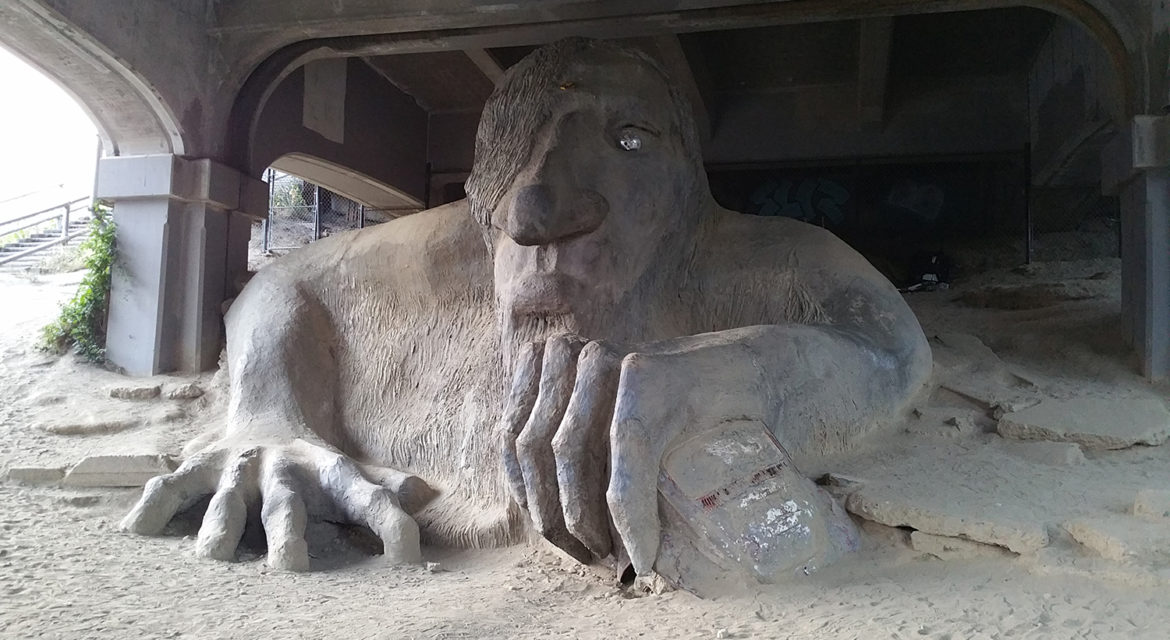There are multiple approaches to enacting figurative and literal change to and for a neighborhood. Providing the people in that neighborhood with something to be proud of is an essential element in this kind of transformation, and it’s one the community of the Fremont neighborhood in Seattle, Washington focused on in their efforts to create a monumental landmark. That effort ended up creating a legacy that has and continues to personify a monumentous transformation of the entire community.
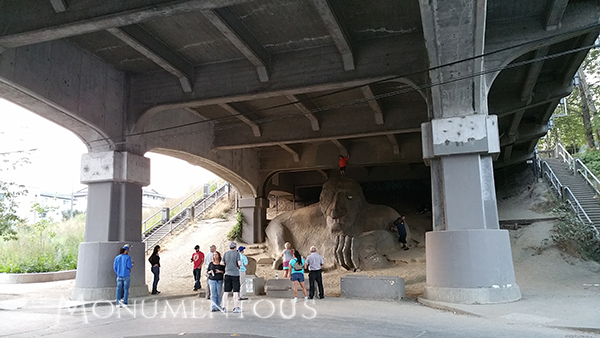
The Fremont Troll began life as a community contest that was designed to transform a trash site under a bridge, but has evolved beyond this original intent into a destination itself. The Troll has been featured in films, books, music videos and television. It’s a road-side attraction that literally pulls people into the area by the busload. By some reports, the Troll is second only to the Space Needle as the recognized symbol of Seattle, with the change it is part of for the Fremont neighborhood personifying something that is far more important than a simple tourist attraction.
The fact that the community drove the creation of this monumentous structure is literal proof of the influence projects conceived with intention can have. The Troll has contributed to economic and cultural changes in the Fremont neighborhood, and those changes can be seen in countless ways. Transformation of this sort is not a simple task, and enabling it can mean confronting challenges that have as much to do with the identity of a community as they do with how that identity might change.
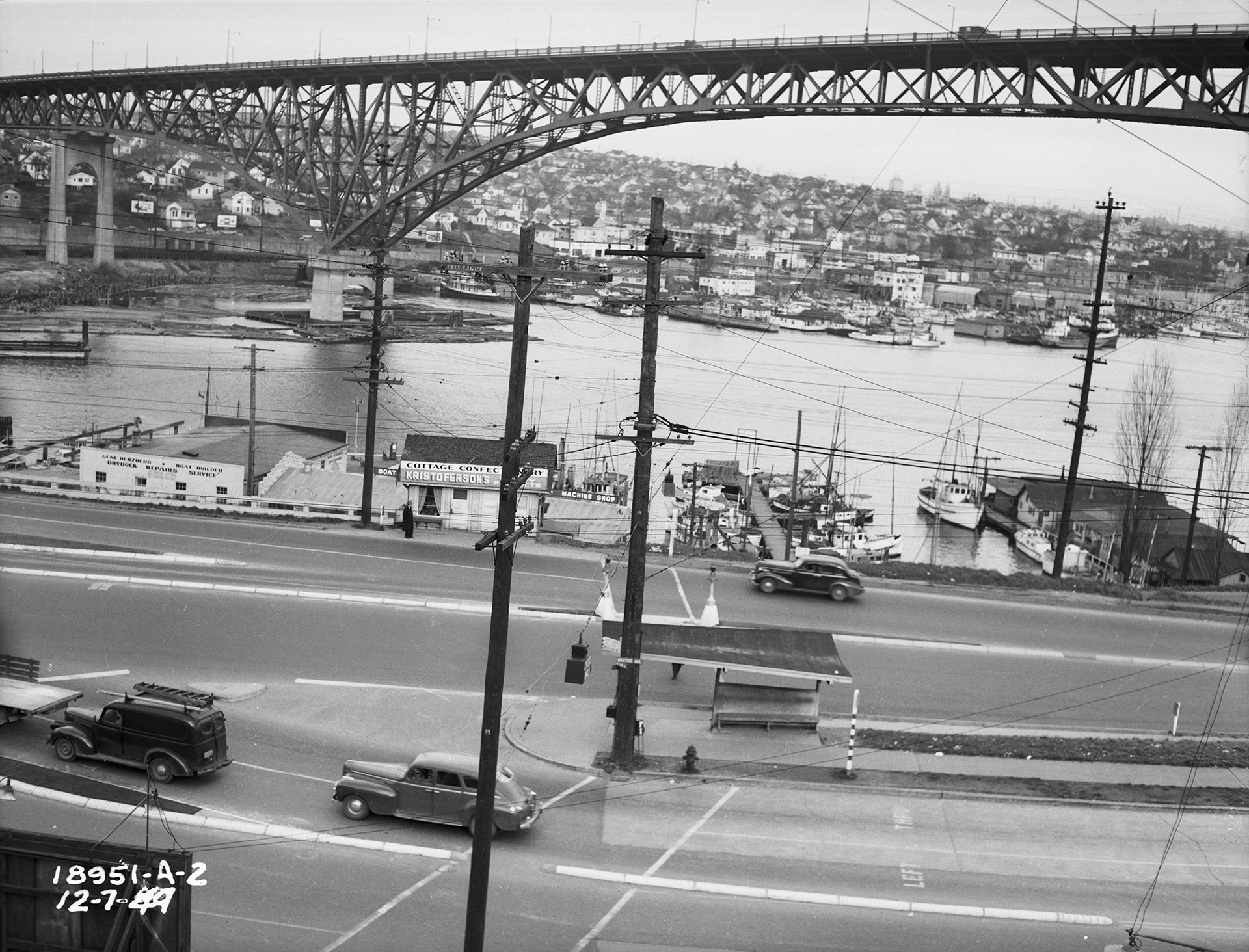
A Challenge and an Opportunity
Fremont is a neighborhood in Seattle located along a body of water that links Lake Washington to the Puget Sound, which itself is an inlet of the Pacific Ocean. It’s an area that was first defined at the turn of the 20th century by a sawmill, warehouses, and the sort of working class people that made a living in those places. The closing of the sawmill saw the area fall into disrepair, which impacted the type of people that were living there. By the 1960s, the area had developed a reputation that was less than favorable.
“In the late ‘60s, people would ask where I lived, and I would tell them Fremont,” said Roger Wheeler, an early member of the Fremont Arts Council, for a documentary focused on The Fremont Troll. “And they’d say, ‘aren’t you scared?’”
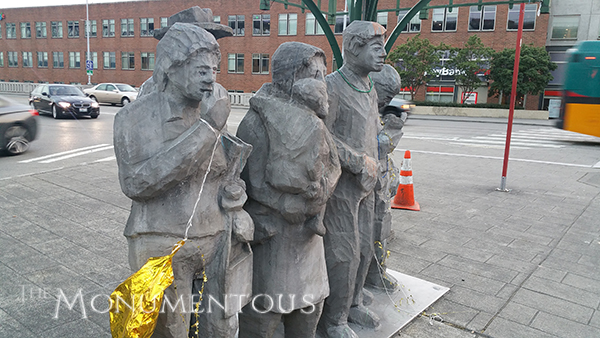 Fremont’s reputation also meant studio space was cheap, which meant that artists like Wheeler could find a place to live and work there, and he wasn’t alone. Because of the amount of artists in the area, the Fremont Arts Council was formed as an original program of the Fremont Public Association — now Solid Ground — and that led to the creation of projects like Waiting for the Interurban, a cast aluminum sculpture of six life-sized people and a dog waiting for the old Interurban streetcar.
Fremont’s reputation also meant studio space was cheap, which meant that artists like Wheeler could find a place to live and work there, and he wasn’t alone. Because of the amount of artists in the area, the Fremont Arts Council was formed as an original program of the Fremont Public Association — now Solid Ground — and that led to the creation of projects like Waiting for the Interurban, a cast aluminum sculpture of six life-sized people and a dog waiting for the old Interurban streetcar.
The piece was something that many people in the community could share and identify with in an incredibly personal way. People spontaneously began interacting with the sculpture by dressing it up and posing for pictures with it. The piece not only showed them how projects like these could literally transform an area of a neighborhood, but also helped everyone see and understand what it meant to create a shared experience.
“When I was growing up, this was a neighborhood of purse snatchers and drug users,” said Kirby Laney, a lifelong Fremont resident and publisher of The Fremocentrist. “The art really brought us together and gave us an identity. It also gave people a reason to come here that went beyond drugs and purse snatching. The art gave people a focal point. Whether you loved it or hated it, it was something for all of us to rally around.”
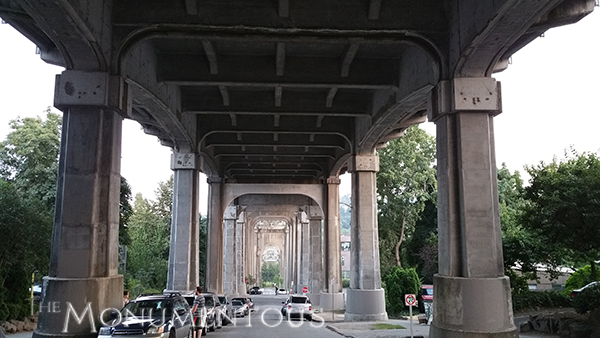 That desire to rally around something soon became focused on the space under the Aurora Bridge in 1990. The area beneath the bridge has been referred to as the “Hall of Giants,” so named for the workers who built the bridge. Others have called it the “Cathedral of Fremont” due to the beauty of the corridor between the support columns. Located in the heart of a residential area, that beauty and location just made the pile of trash that collected in the space at the end of the street that much more unseemly.
That desire to rally around something soon became focused on the space under the Aurora Bridge in 1990. The area beneath the bridge has been referred to as the “Hall of Giants,” so named for the workers who built the bridge. Others have called it the “Cathedral of Fremont” due to the beauty of the corridor between the support columns. Located in the heart of a residential area, that beauty and location just made the pile of trash that collected in the space at the end of the street that much more unseemly.
There’s a limit to what can be done with the area where a bridge connects to the ground, because there still needs to be access if the bridge needs to be repaired. That created a negative space under the Aurora Bridge, which lied fallow. No matter how often it was cleared, garbage kept piling up.
The response from Waiting for the Interurban along with other art projects from the Arts Council’s early years, and the challenges associated with this space created an opportunity that members of the Fremont Art Council recognized and acted upon. That recognition was an essential element in the creation of The Fremont Troll.
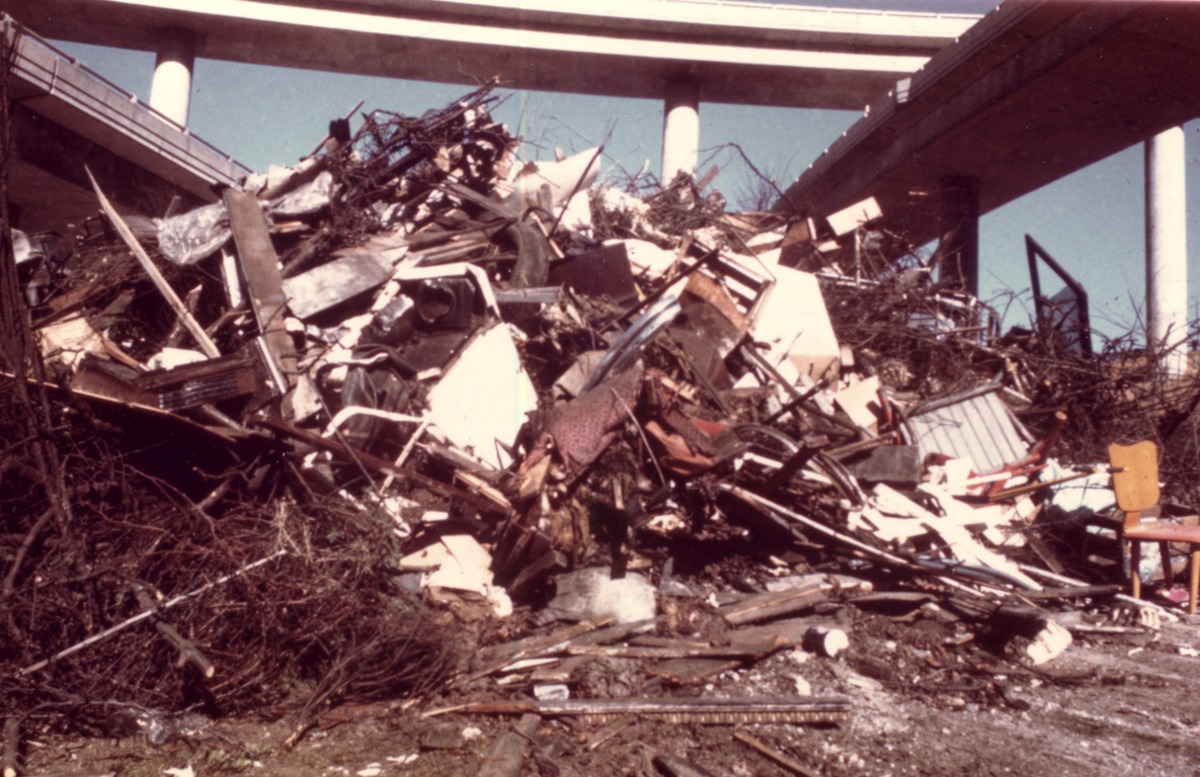
Literal and Figurative Changes
While Fremont did have a less than stellar reputation, things were already beginning to change in the neighborhood as plans for The Fremont Troll began to take shape. Quadrant was in the process of acquiring construction permits to redevelop the warehouses along the Ship Canal into office buildings. The city of Seattle itself was getting bigger in the 1980s, and high-tech industries had begun to move into the area. Real estate values doubled from ’88 to ’90. All of that made it important for the stakeholders in Fremont and in the Fremont Arts Council to ensure they would be able to influence this transition, rather than be defined by it.
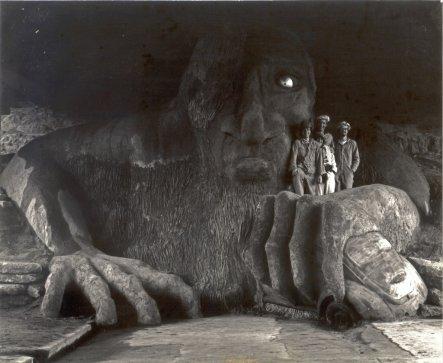
How this spirit influenced what ended up going under the bridge was part of the focus of The Hall of Giants, a documentary about the people, places and times that produced The Fremont Troll. Director Michael Falcone talked with many of the principles that were involved with the project, including the four artists, Steve Badanes, Will Martin, Donna Walter and Ross Whitehead. These conversations have given him incredible insight into the people and process that made the Troll a reality.
“The Fremont Arts Council put out a call for artists to submit sketches of what they’d like to see under the bridge, as the area on either side of the bridge had been much improved already,” said Falcone. “Barbara Luecke was approached about a new program called the Neighborhood Matching Fund. They saw it as a way to fund a new revitalization effort, one that could incorporate a large public art piece to tie the park spaces on either side of the bridge together. Enthusiasm was high once Will Martin and Ross Whitehead’s model of the Troll won the public vote for the project’s design.”
Luecke is a key figure in Fremont and Troll history, and helped ensure the project got community support. Peter Bevis, a key community activist in Fremont at the time, had the idea of allowing the public to vote for their favorite design, and made having opportunities for people to help build the artwork a requirement of the submitted designs. That community involvement ended up being a driver in more ways than one, as the idea to put the designs up for a vote from the community was met with scorn in some areas, which the media was eager to cover. Letting the public vote around this type of decision and help create the artwork was not a common practice, but that ended up making all the difference in the world.
So many projects and pieces of public art are produced in a vacuum, which means that the people who see and interact with these pieces everyday have little connection to them. The Troll is proof of why that approach can be such a missed opportunity, because the voting process allowed everyone to get involved and identify with the project in a way they would not have otherwise. Many of the volunteers who helped on site became involved with the Arts Council for many years afterward. This was what the community wanted, which meant the project would never just be a sculpture or piece of public art. That fact became the impetus for figurative and literal changes to Fremont.
While the crime and drugs that had dominated Fremont were in the process of being pushed out before the Troll went up, there were still issues when it came to the enforcement of laws. The Troll brought positive attention to the area to help further diminish these influences, and resonated beyond the tourists who wanted a chance to climb the Troll and snap a picture. People have gotten married in front of the Troll. It’s literally and figuratively become an essential part of the community.
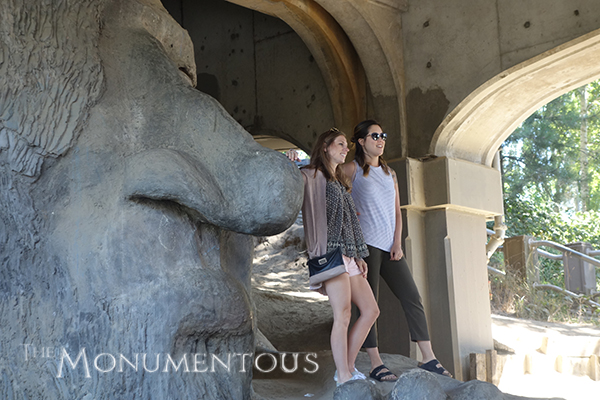 That resonance is part of the reason why the Troll is a major aspect of The Fremont Tour, a playful walking tour through Fremont that’s designed to be a fun way to explore the neighborhood. It’s an attraction that pulls people in from across the world, which is ultimately about far more than a sculpture under a bridge.
That resonance is part of the reason why the Troll is a major aspect of The Fremont Tour, a playful walking tour through Fremont that’s designed to be a fun way to explore the neighborhood. It’s an attraction that pulls people in from across the world, which is ultimately about far more than a sculpture under a bridge.
“The Troll is a fun attraction to see and unique to Fremont,” said Mark Ukelson from The Fremont Tour. “There are always people at the Troll when we stop during our walking tour which adds to the spontaneity of how we present it on the tour. We present the Troll as a piece of public art that transformed a neighborhood garbage dump into a place of community celebration which is a good way to promote public art.”
The omnipresence of visitors flocking to the underside of a city bridge represents quite a change for Fremont, and it’s one that’s meant there are few times when someone isn’t at the Troll. It helped clean up a run down area, but did much more to clean up the reputation of the neighborhood itself. It’s an attraction for tourists and locals, and every Halloween a birthday celebration called Trolloween takes place at the site. All of these things directly and indirectly influence the economy of the neighborhood.
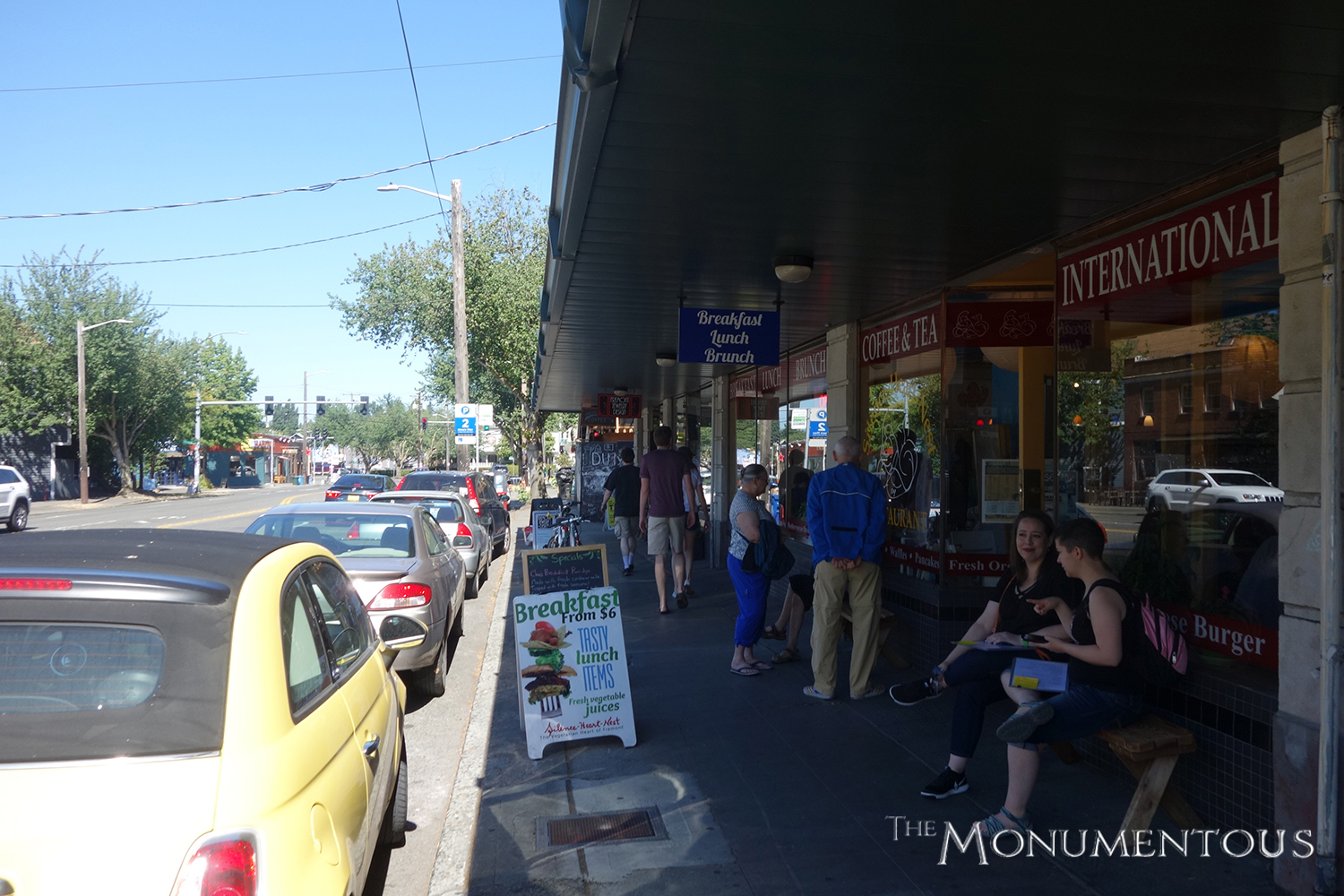
The Economic Impact of the Troll
The amount of foot-traffic that results from all of the activity around the Troll trickles down to the businesses that surrounds the area, many of which have gone up since the piece was completed, and the new office complexes moved along the Canal. While it’s hard to quantify the economic impact of the Troll, the difference it’s made can be seen in those businesses that are currently in operation in the neighborhood.
There are numerous restaurants, coffee shops, wineries and bars through the area, many of which have gone in since the Troll did. Many more office workers are employed in Fremont than have ever been in the area. Tourist shops that sell items related to the neighborhood and the city exist because of the influx of people who come to see the Troll. With so many other attractions in the neighborhood, their visits are seldom brief or solely focused on the Troll.
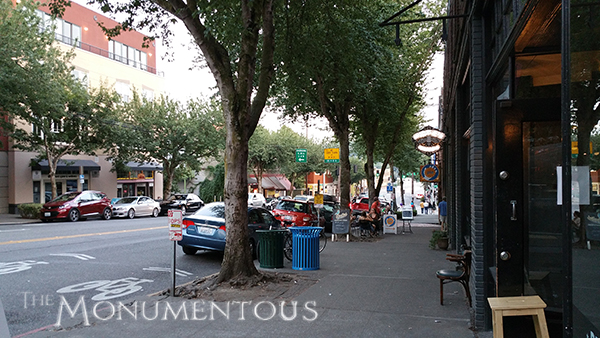 Being able to see more than the Troll is a major element in the economic transformation of the entire area though, and it’s a further illustration of the fact that these businesses aren’t thriving because of one particular change or development. Instead, they’re in the area and doing well because of a process that started before the Troll was conceived, and continues to this day.
Being able to see more than the Troll is a major element in the economic transformation of the entire area though, and it’s a further illustration of the fact that these businesses aren’t thriving because of one particular change or development. Instead, they’re in the area and doing well because of a process that started before the Troll was conceived, and continues to this day.
“The changes in businesses aren’t specific to the Troll,” said Laney. “The Troll installation was a punctuation around an ongoing effort, and as the neighborhood improved you got a different set of businesses. It wasn’t specific to the Troll though, but more to the fact the neighborhood has become a place to be.”
That transition from a purse-snatching area into a “place to be” is one that didn’t take place overnight, and it’s not one that is the result of a single piece of art or monument. Saying the Troll enabled the transformation Fremont has experienced would be false, but a quick tour through Fremont provides you with all the proof you need to understand the significance of the piece.
“Many people come to Fremont because they are looking for some fun attractions like our many public art pieces,” Ukelson mentioned. “Many thousands come to Fremont during the summer, particularly on Sundays. The economic benefits go to the neighborhood restaurants and small businesses. It is well established and listed in many of the major travel guides.”
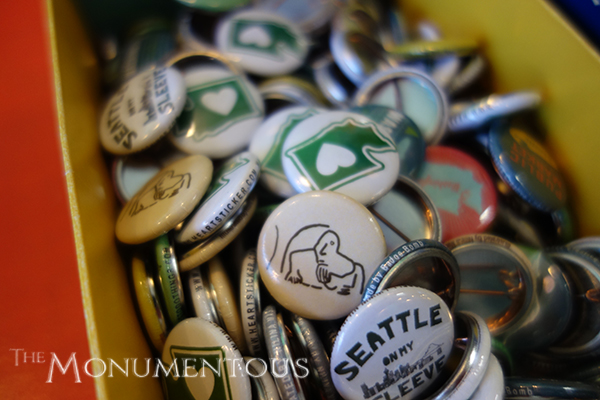 That fact makes the Troll, and in turn Fremont itself, a destination for visitors from across the world. Tourists choose their destinations based on a variety of factors, but giving them something specific to see and go to makes them that much more likely to choose one location over another, and even one destination over another.
That fact makes the Troll, and in turn Fremont itself, a destination for visitors from across the world. Tourists choose their destinations based on a variety of factors, but giving them something specific to see and go to makes them that much more likely to choose one location over another, and even one destination over another.
Economic impact at this scale is something that cuts across multiple years and industries, but the activity and businesses in the area are proof positive of that impact. It’s something that can be seen in everything from those large buses of tourists driving by the Troll down to tiny buttons that have the Troll on them. All of these things have influenced and changed the culture of Fremont and the economic conditions of the people who live and work there. However, it’s important to remember that there’s always another side to change.
 Change as a Double-Edged Sword
Change as a Double-Edged Sword
Some of the people and businesses that were opposed to the construction of the Troll remain in the area, but many of the bars and shops that dominated the area in the ‘60s and ‘70s have moved on. Those who have decided to leave did so not only because of their apprehension at being part of the transition of the area, but also because of what being part of that transition represented.
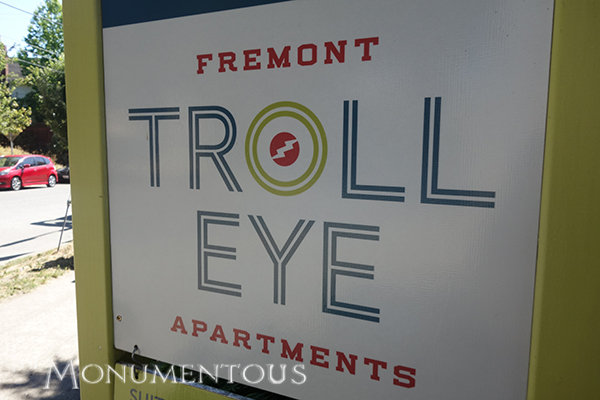 “We knew in 1990 that things were going to change,” Ross Whitehead was quoted saying for The Fremont Troll documentary. “It’s a lot more predictable now. It’s what we feared Fremont might become.”
“We knew in 1990 that things were going to change,” Ross Whitehead was quoted saying for The Fremont Troll documentary. “It’s a lot more predictable now. It’s what we feared Fremont might become.”
What Fremont has become is a place where many feel the considerations around putting up a sculpture or statue is based on a cost-benefit analysis, rather than pure aesthetics or a fit for the neighborhood. It’s an issue that comes up in neighborhoods and even entire cities that experience these kinds of transitions. As proof of that, not many of the people who were involved with the creation of the Troll are able to afford to live in the neighborhood any longer.
The influx of people into a place that is on the way up can means those who lived there specifically because they could afford it are priced out. It’s a transition that can redefine the identity of the community, but these kinds of changes are often a matter of perspective.
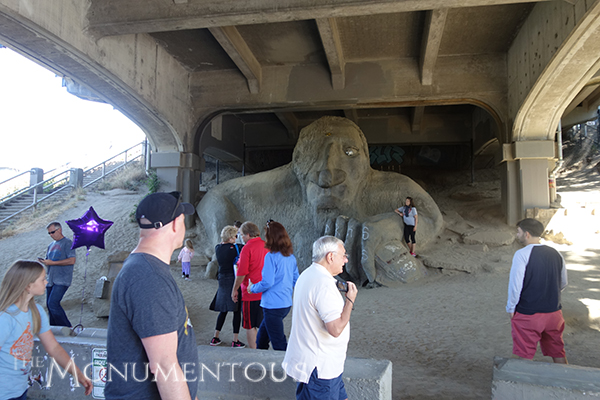 “I’ll often come across people who will tell me about old Fremont and how much better it used to be,” said Laney. “So I’ll ask them how old they were when they thought Fremont was great, and most of the time they say it was when they were in college. So really, they’re telling me that being 19 and in a neighborhood where you could drink and do whatever you wanted was great. However, living in that kind of neighborhood, where I had to literally clean up after all of that, was not so great.”
“I’ll often come across people who will tell me about old Fremont and how much better it used to be,” said Laney. “So I’ll ask them how old they were when they thought Fremont was great, and most of the time they say it was when they were in college. So really, they’re telling me that being 19 and in a neighborhood where you could drink and do whatever you wanted was great. However, living in that kind of neighborhood, where I had to literally clean up after all of that, was not so great.”
There are two sides to any kind of change, and there will always be people unhappy about what a transition like this represents to them personally. However, projects like the Troll are bigger than any one person, because they can positively impact and build an entire community. Doing so shouldn’t mean a neighborhood loses the identity it has established, which means the obligations of a community in the present need to be balanced out with the promise of what can happen for it in the future.
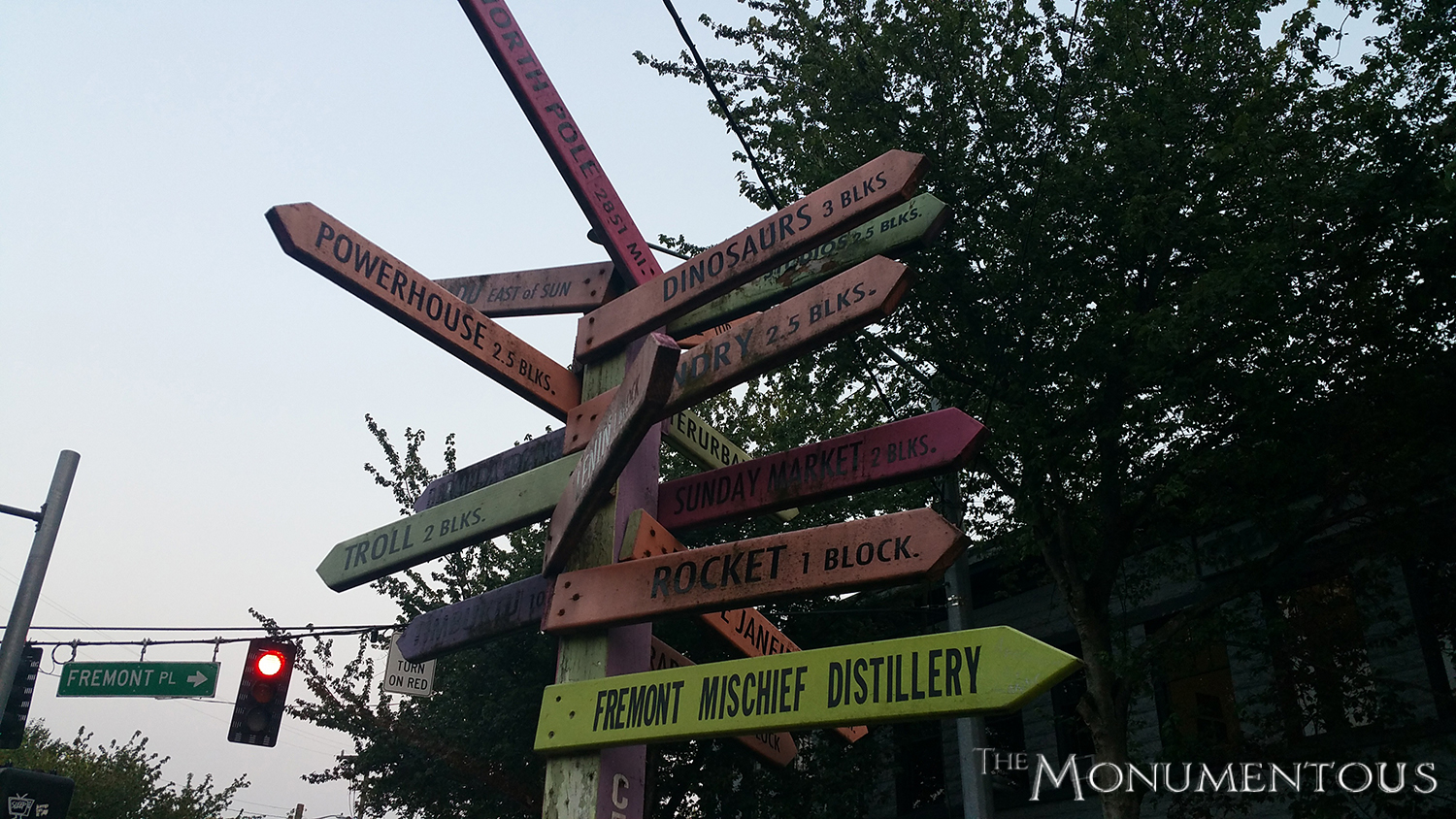 World Without the Troll
World Without the Troll
The challenges associated with transitioning empty or negative spaces like the one that used to reside under the Aurora Bridge are numerous. Issues with budget, bureaucracy and permission are just the beginning of the conversation, and that’s before a potential idea or concept is discussed. It’s an issue that even the stakeholders of The Fremont Troll realize.
“It’s hard to know if we were doing it now if we’d get the same outcome,” Barbara Luecke mentioned when she was interviewed for the Hall of Giants documentary. “I’m not certain those same choices would have been made now.”
Today, the neighborhood faces different challenges when it comes to projects of this type, many of which have to do with approval, zoning and cost. Luckily, some of the results have been same, as the J.P. Patches Statue sits less than a mile from where the Troll resides. It’s a reminder that the transformation of Fremont is an ongoing process that doesn’t start or stop with one specific event or installation. The influence of the piece also extends beyond the neighborhood.
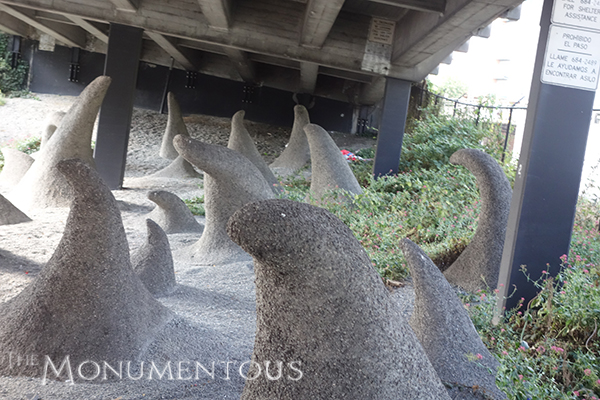
There are many bridges in Seattle that meet the ground in the same way the Aurora Bridge does, but all of them were empty when the Troll was being commissioned and built. Today, pieces such as The Wall Of Death the Wave Rave Cave reside under bridges.
Challenges with enabling projects of this nature are unique to particular places and times, but there are plenty of lessons to be learned from the Troll. Fremont Troll artist Donna Walter spent time going door to door to raise funds and awareness for the project, which is a great example of what it takes to get the support of an entire community. The matching fund programs that the Fremont Art Council was able to utilize might not be an option everywhere, but similar types of programs exist at local, state and federal levels. Anyone committed to a project of this type has options.
The Troll doesn’t exist because an administrator from the government decreed that it was to be made, but because a group of people got the support of their community. They made it happen on less than a shoestring budget, with everyone from contractors to kids volunteering their time and effort. It exists because the people in the neighborhood came together to work on something that was bigger than all of them, which is something they took to heart.
“The Troll has been bringing people together ever since it was just an artist’s concept,” said Falcone. “It’s given the community a sense of pride and identity. Fremont has a reputation for being whimsical, funky, and artistic, and the Troll is the fifteen-foot ambassador to all that. People come to crawl all over it, look at it from different angles, and feel dwarfed by its sheer size. I live in Fremont, and having the Troll in my neighborhood makes me feel closer to the community that it’s surrounded by.”
The ability to climb onto the Troll itself has gotten the people who stop by to think of these monuments in a different way, because of the personal experience they can have with it. Some children are scared of the Troll at first, but many eventually see that the Troll isn’t going to harm them. This realization feeds into the kind of change in approach and mentality for everyone who views the piece.
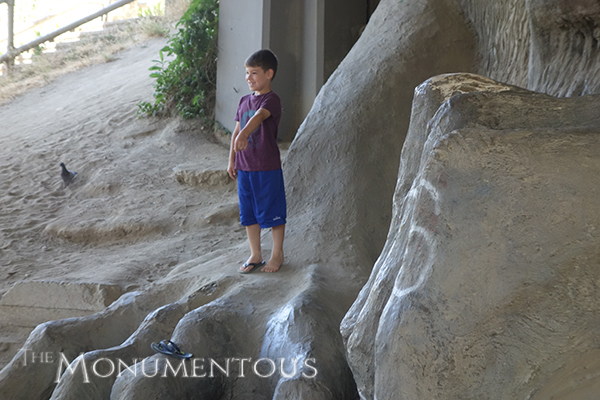 It’s incredibly difficult to look at a negative space and envision not only what could be there, but to also run through the logistics that need to be cleared to make it happen. The project is proof that if there’s an available space that can’t be utilized for much, what’s to lose by trying to make something happen with it?
It’s incredibly difficult to look at a negative space and envision not only what could be there, but to also run through the logistics that need to be cleared to make it happen. The project is proof that if there’s an available space that can’t be utilized for much, what’s to lose by trying to make something happen with it?
All of that might still not be enough to push through projects like this though, and it might not have been enough for The Fremont Troll. The involvement of the community really made a difference and represents the single biggest factor around this formerly negative space now being able to attract people to it by the busload.
A sculpture of a troll living under a bridge might be ingenious to some, silly to others, and everything in between to the rest. What matters isn’t the specific reaction a person might have, but that people from the area and across the world come to Fremont to have those reactions and a personal experience with the sculpture. It’s a fact that has been no small part of the transformation of the entire neighborhood.
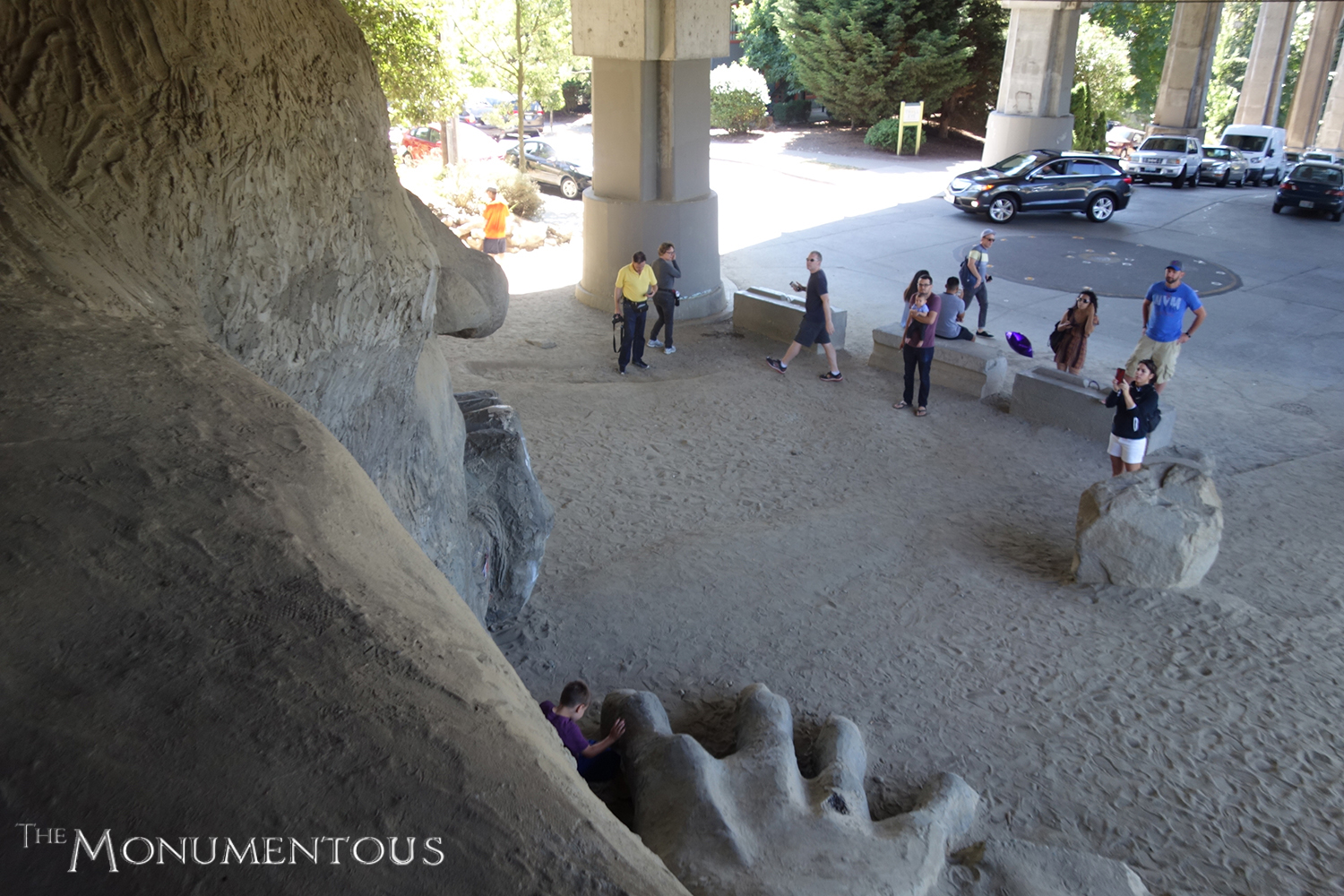
Special thanks to Mike Falcone for his help with putting this piece together. If you want to learn more about The Fremont Troll, please check out his aforementioned documentary, The Hall of Giants.
